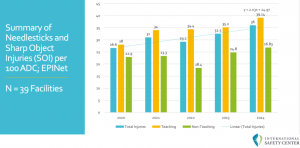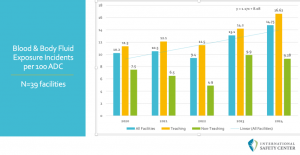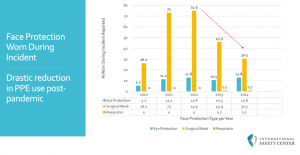International Safety Center Posts Long-Awaited 2024 EPINet Data, Announces its Closing, and Transition to AOEC
Annual EPINet Occupational Incident Data Show Rise in Healthcare Worker Exposures to Infectious Disease. Center Announces Closing. Transition to AOEC.
It is because of the foresight, compassion, dedication of the AOEC Leadership, that you can continue to access EPINet data for use in building stronger injury prevention and worker education programs.”
LEAGUE CITY, TX, UNITED STATES, July 10, 2025 /EINPresswire.com/ -- The International Safety Center (ISC) convened its Board of Directors to review the 2024 annual Exposure Prevention Information Network (EPINet®) data, complied from US healthcare facilities on injuries from needlesticks, contaminated sharps, and mucocutaneous occupational exposures to bloodborne and infectious disease (e.g., HIV, HCV, influenza, COVID-19). The Center has been collecting this kind of surveillance data since the mid-1990s and reports it publicly every year.— Dr. Amber Mitchell
Under the stewardship of Dr. Amber Hogan Mitchell, ISC's President and Executive Director and Ginger Parker, ISC’s Chief Information Officer, the board delved into the data. Data revealed a need for renewed focus on building operational frameworks for reducing occupational infectious disease, especially those related to exposures to blood, body fluids, and other potentially infectious materials.
2024 EPINet Summary Data
In place since the mid-1990s, EPINet represents the only multi-state data source for occupational needlesticks, contaminated sharps injuries, and high-risk mucocutaneous exposure incidents.
2024 data illustrate a clear uptick in numbers of injuries across all categories over the last 5 years – especially for hypodermic syringes (mostly nurses) and suture needles (mostly physicians). Despite enormous risk, especially during the COVID-19 pandemic, healthcare workers continue to be at higher risk than previous years of bloodborne pathogens exposures due to the sheer increase in numbers of injuries. With the same number of EPINet network facilities contributing their data in 2024 as in years past, there were 1,945 needlesticks and sharps injuries reported through the EPINet network of healthcare facilities (N=39 facilities) compared to 1,687 in 2023 (a 10% increase). For splash and splatter incidents (mucocutaneous), there were 797 in 2024 compared to 678 in 2023 (a 15% increase).
In addition to increases in frequencies of mucocutaneous exposures, personal protective equipment (PPE) use is down, especially for the highest risk exposures – those to unprotected eyes. Employees reporting a mucocutaneous exposure incident (eyes, nose, mouth), indicated that they were only wearing PPE on their face less than half the time (43%) and only 12.8% wore any kind of eye protection during an incident.
Based on most recent data, more must be done to protect the health and safety of this critical workforce. Unfortunately, despite the concerted efforts of both the ISC board and staff to secure ongoing funding and support, no foreseeable path exists for ISC to continue its important work. Disappearance of Center funding was not related to changes in the current Presidential administration, rather it has been an ongoing struggle across all administrations over the last decade.
International Safety Center Closing
Based on these difficult circumstances, the ISC board and executive staff sadly announce that ISC will be officially disbanding. From the beginning of its inception as the International Healthcare Safety Worker Center housed at University of Virginia, led by Dr. Janine Jagger and her dedicated and talented staff, it has been an honor to carry its mission forward.
ISC has long served as a data source providing ongoing support for the OSHA Bloodborne Pathogens Standard and CDC and NIOSH’s guidance on infection prevention in healthcare. The Center became a stand-alone non-profit in 2015 and has managed to keep its doors open to the world from private funding through grants from medical device manufacturers. With funding no longer available, the opportunity to use its resources to drive safety and needed policy change also ceases.
Transition of EPINet over to AOEC
The Association of Occupational and Environmental Clinics (AOEC) Board of Directors has approved moving ISC’s pivotal EPINet Data over to their domain at www.aoec.org/epinet. Thanks to the foresight, compassion, and dedication of the AOEC Board and its members, you can now continue to access EPINet data for use in comparison data, trending information, and policy support.
The AOEC has been in existence as an IRS-designated 501c3 non-profit since the late 1980s. Its members are occupational and environmental medicine (OEM) clinics and individual professional members that come together to provide high-quality, patient-focused care for workers injured or ill on the job and people exposed to environmental hazards. AOEC’s referral network is the only of its kind that helps workers, their employers, and their family medicine and urgent care clinicians find specialists that can treat them for both acute injuries (e.g., amputations, lacerations, breaks, sprains, etc.) and chronic work-related illnesses (e.g., silicosis, Black Lung, Sept 11 workers, repetitive motion, HIV exposures, and more). AOEC’s members assist labor unions, community-based organizations, disaster recovery groups, and others identify exposures and hazards, so that they can diagnose and treat workers and advocate for safer work environments and communities.
As the host of this data, AOEC staff can provide incidence and prevalence of needlesticks, sharps injuries, and mucocutaneous exposures across healthcare settings. It can also provide insights into compliance with sharps with injury prevention (SIP) devices (aka safety-engineered devices). And, AOEC will have the ability to provide data on engineering controls, work practices, and PPE use that contribute to greatly reducing occupational risk.
What’s Next?
It is imperative that guidance on medical device safety and PPE use continue to workers in all settings of patient and resident care. Such guidance also contributes to creation of more effective policies and worker-based training programs focused on infection prevention and strengthens collaboration between healthcare providers, employers, unions, advocacy groups, and policymakers. Ongoing injury surveillance and data reporting will also enhance efforts to promote the use of more effective "safety engineered" sharps injury prevention devices and PPE use to reduce worker injuries and the risk of occupational exposure to bloodborne pathogens and infectious disease.
EPINet data remains publicly available. Everyone is encouraged to delve deeper into EPINet findings to actively contribute to AOEC and its initiatives and join as a member of AOEC. EPINet data can be accessed here. Continued collaboration, adoption of evidence-based strategies, and improved surveillance will be essential for upholding safety standards and protecting workers in the healthcare sector.
Thank you to the quick, thorough, and quality web and IT work of Jess Ferko, Back Pocket Media and Colin Thomas, TechSource One. Thank you to both ISC and AOEC Boards, members, and contributors.
Amber H Mitchell
AOEC
+1 713-816-0013
email us here
Visit us on social media:
LinkedIn
Legal Disclaimer:
EIN Presswire provides this news content "as is" without warranty of any kind. We do not accept any responsibility or liability for the accuracy, content, images, videos, licenses, completeness, legality, or reliability of the information contained in this article. If you have any complaints or copyright issues related to this article, kindly contact the author above.



